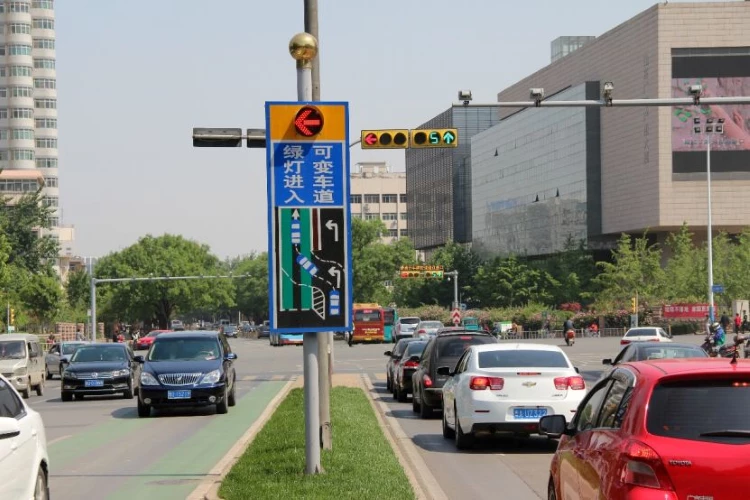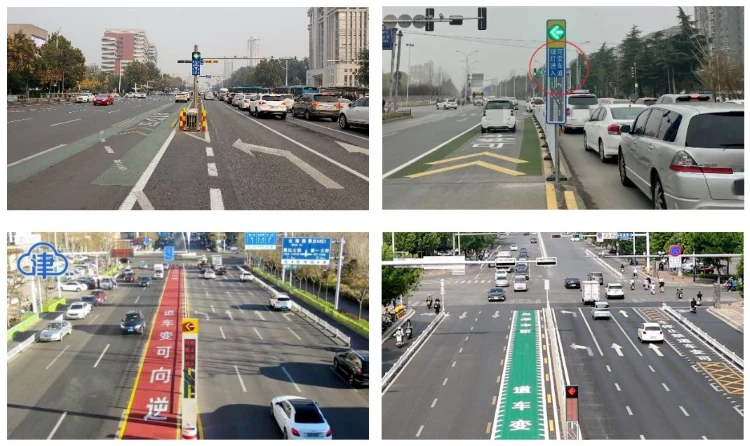The article about the reverse variable left-turn lane is provided by our media partner 7ITSNews.
With rapid urbanization and growing vehicle ownership, the imbalance between road supply and traffic demand is intensifying. Intersections, the key nodes of urban traffic congestion, are under increasing pressure. Improving their efficiency through smart traffic management solutions has become a critical task for modern cities. The reverse variable left-turn lane represents an innovative traffic management model that optimizes time-space utilization at intersections. By dynamically adjusting lane functions, it significantly increases left-turn capacity without widening roads or adding lanes—providing an effective, low-cost approach to urban traffic optimization.
Definition and Core Mechanism of the Reverse Variable Left-Turn Lane
At the heart of this innovation is a simple but powerful idea: using existing road space more intelligently. The reverse variable left-turn lane is a designated lane positioned on the inner side of an intersection’s exit approach, and its purpose changes dynamically depending on the traffic signal phase. During the left-turn phase, the lane temporarily functions as an additional left-turn lane, allowing vehicles to “borrow” the opposing lane for queueing. When the signal switches to the through phase, it reverts to its original role as an exit lane, seamlessly reintegrating with the regular flow of traffic.
This concept relies on the principle of time-space reuse, transforming what would otherwise be idle exit-lane capacity into a temporary buffer for left-turning vehicles. The effect is tangible: smoother traffic at intersections, reduced congestion, and improved overall throughput — all without widening roads or adding new infrastructure.
The system’s advantages are clear. It allows for efficient use of time-space resources by dynamically switching lane functions. It offers adaptive flexibility, responding to real-time traffic conditions to balance left-turn and through movements. And importantly, it delivers cost efficiency, as implementation requires only minor adjustments such as new lane markings, signal upgrades, or guidance signage.
Application Scenarios and Implementation Conditions
Not every intersection needs a reverse variable left-turn lane, but for the right locations, its impact can be significant. The design works best where left-turn demand is high and existing road width makes it impossible to add new lanes. It is also a strong fit for intersections where through traffic is already at capacity or where time-space resource conflicts between opposing directions are particularly severe.

To implement the system effectively, several basic conditions must be met: the approach should already have a dedicated left-turn lane and a protected left-turn signal phase; the exit must feature at least two lanes to accommodate switching functions; and the intersection geometry must provide enough internal space for safe turning radii. Because of these technical requirements, the design should always be guided by careful traffic flow analysis, rather than applied universally.
Technical Implementation and Optimization Strategies
Deploying a reverse variable left-turn lane system requires synchronizing physical modifications with intelligent signal control. On the hardware side, engineers create an opening on the inner side of the exit lane, using colored markings to clearly define the functional zone. Real-time lane status displays—showing messages such as “Left-Turn Active” or “No Entry”—help drivers adjust their behavior instantly. In some cases, optimizing the opening’s position or introducing U-turn restrictions can further reduce conflicts.
Signal control is equally important. One effective strategy is adopting a “left-turn first, then through” sequence, allowing vehicles to queue ahead of time and pass quickly once the left-turn phase begins. Dedicated signals for the variable lane must be precisely synchronized with the main intersection lights, and phase timing should be adjusted dynamically based on traffic demand and lane-length capacity.

Case Studies and Promotion Results in China
Jinan: The Pioneer City
The city of Jinan was the first in China to experiment with this design. In May 2012, traffic police introduced a reverse variable left-turn lane at the Jingshi–Huanshan intersection. After demonstrating clear improvements, the concept quickly spread — today, more than 40 intersections in the city have adopted the model, significantly enhancing efficiency and safety.
Shenzhen and Tianjin: Expanding the Model
Other major cities soon followed. In Shenzhen, authorities introduced “borrowing lanes for left turns” in 2015 and later expanded the practice across the city. In Tianjin, the model was rolled out in 2021 in the Binhai New Area, where dynamic use of the opposing lane helped alleviate peak-hour pressure.
Results and Urban Impact
The outcomes speak for themselves. Cities that have adopted the reverse variable left-turn lane report a notable increase in intersection efficiency, as dynamic allocation eases the conflict between left-turn and through traffic. The financial advantages are also considerable: single-point modifications cost only a fraction — roughly one-fifth to one-tenth — of traditional road-widening projects. And because the design is highly adaptable, it can be tailored to the unique geometry and traffic patterns of each intersection.
This approach marks a broader shift in urban traffic optimization — from expanding physical infrastructure to optimizing what already exists. It demonstrates how cities can achieve significant performance gains through targeted, data-driven interventions rather than costly construction.
Toward Smarter and More Resilient Urban Road Networks
Ultimately, the reverse variable left-turn lane illustrates how thoughtful, data-informed design can reshape urban mobility management. As technologies such as AI, IoT, and intelligent transportation systems (ITS) continue to evolve, this model is well positioned to integrate into next-generation mobility networks. Scalable, efficient, and sustainable, it offers cities a practical pathway toward more resilient and adaptable road systems — and a smarter future for urban travel.
About the authors: Zhao Yue, Wang Shoukuan, Shandong Jiaotong University, Zhixing Traffic Engineering Co., Ltd.
Read more about smart and sustainable mobility here, here and here.


